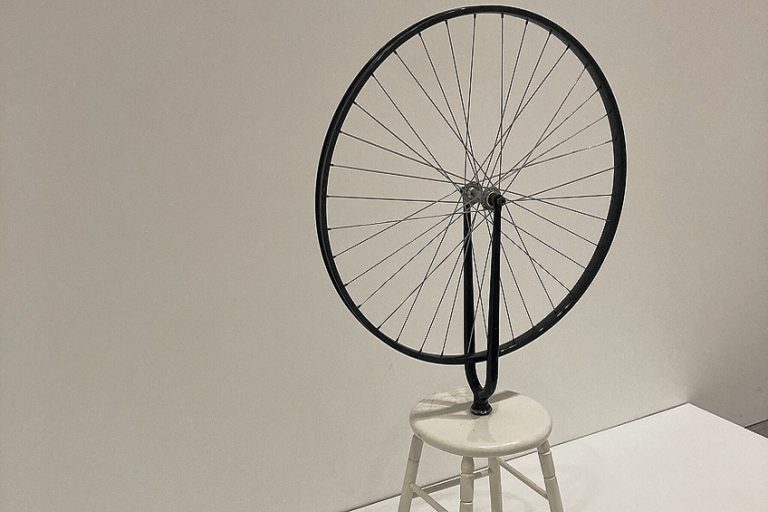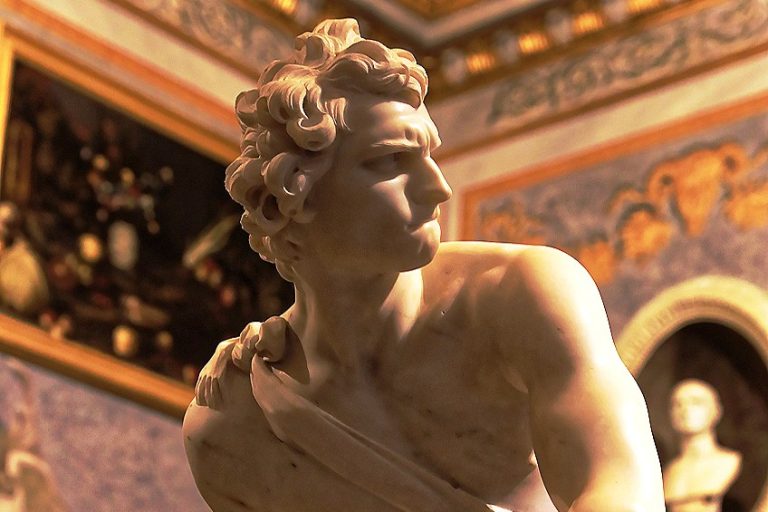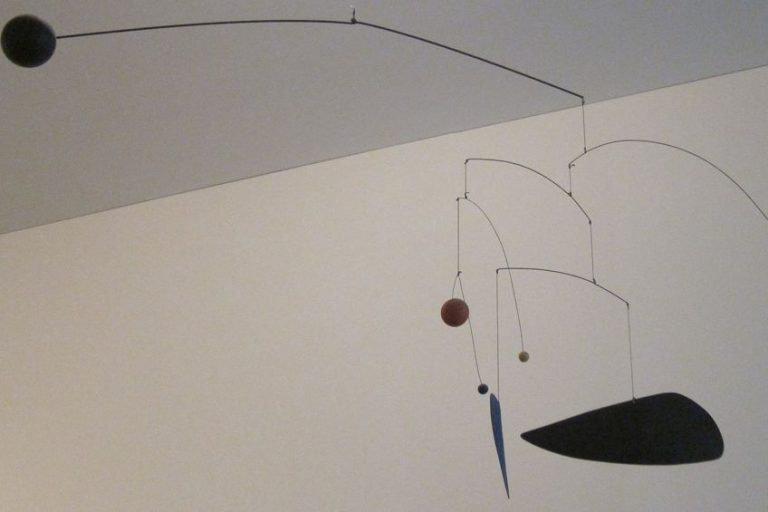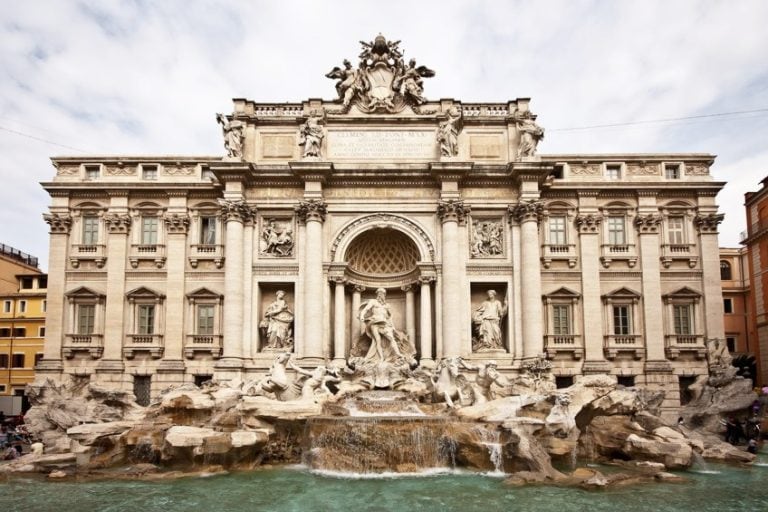Medusa With the Head of Perseus – A Fresh Take on the Perseus Statue
Medusa With the Head of Perseus is a work of art that turns the old Greek mythological tale on its head, so to speak. It was sculpted by Italian artist Luciano Garbati who in his youth, would often see Benvenuto Cellini’s Medusa and Perseus sculpture at the Loggia Dei Lanzi in Florence, close to his hometown. He often wondered why the woman who had been raped was the one who was persecuted in the myth, and so decided to create his own version where she is triumphant. It would depict Medusa holding Perseus’s head instead, reversing the roles to portray a more modern outlook and in doing so became a symbol of the feminist movement.
The Story of the Medusa and Perseus Statues
There are two Medusa and Perseus sculptures involved in this story. The one was created in 1554 by Benvenuto Cellini and is located in the Loggia Dei Lanzi in Florence. It would serve as the inspiration for Garbati’s reactionary version which offers a fresh perspective of an ancient story and brings to light the manner in which society often blames the victims instead of the perpetrators. Garbati’s version portrays Medusa holding Perseus’s head instead, which might not mean much unless one has an understanding of the myth itself.
So let us start with an explanation of the ancient Greek tale that prompted the creation of both of these famous sculptures.
The Myth of Perseus and Medusa
Medusa was a devotee of the virgin deity of knowledge and warfare, Athena. One prerequisite for becoming an Athenian priestess is that the youthful girl is pure and chaste and dedicates her life to the goddess. Poseidon, the sea god, and Athena’s adversary noticed Medusa one day and planned to disgrace Athena by sexually assaulting the young woman on the stairs of the Athenian sanctuary. Poseidon then departed, leaving Medusa helpless and feeble.
Medusa begged the goddess for help and compassion. After all, the gods seized their lovers as their partners for life back then, and Medusa was now Poseidon’s bride. Athena was furious and punished Medusa for betraying her. Medusa was banished to a distant island and bewitched so that no male would desire her. She was bestowed with broken skin, serpent tresses, and stony eyes.
Medusa had transformed into a monstrosity.
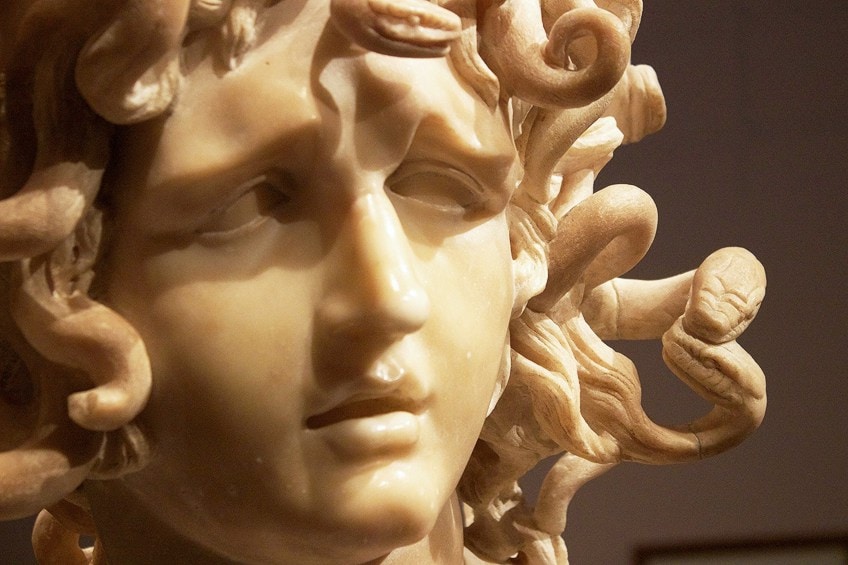
Medusa was exiled from society to her own island. She was alone and all she saw were guys chasing her and attempting to murder her. She stared at them, terrified, and watched them transform to stone right there next to her. She was terrified of her abilities and enraged at the deities for condemning her. She exacted her vengeance on the people who were assigned to murder her. Anyone who ventured even one foot onto her island was now doomed to demise through the stare of the Gorgon Medusa.
Sometime after, Perseus arrived on the island with an Athenian shield, Hermes’ winged sandals, and Zeus’ blade and crown. He outwitted Medusa and beheaded her, taking the head back with him in order to prevent his mom from courting a monster. Medusa’s body gave birth to Pegasus, a flying mare, and Chrysaor, a golden hero.
Countless years later, Perseus brought Medusa’s decapitated skull to Athena, who transformed it into impenetrable armor with a metallic skull of Medusa scaring many foes with a single glance.
Medusa was a devoted person who dedicated her adolescence preparing to become a devotee to a deity she revered and thought to be the most powerful of all the Olympians. Medusa was also favored by Athena since she was a stunning girl who selected the deity above any male. The everlasting hatred between Poseidon and Athena, on the other hand, affects much more than just the deities involved; it divides Olympus and destroys many souls.
Let us now take a look at the original sculpture that was inspired by this tale.
The Tale of Two Sculptures
The myth inspired Benvenuto Cellini to create his original sculpture in 1554. Many centuries later, Luciano Garbati would create his reactionary version by swapping the roles. Let us look at the artists behind these sculptures and the works they created.
Benvenuto Cellini (1500 – 1571)
| Nationality | Italian |
| Date of Birth | 3 November 1500 |
| Place of Birth | Florence Italy |
| Associated Mediums | Sculptor |
While Caravaggio is typically identified as the problematic bad-boy prodigy, renowned for drinking, brawls, and even being accused of murder, Benvenuto Cellini was a similarly crazy, egotistical, and disturbing figure. Cellini is regarded as the finest Renaissance craftsman; indeed, the incomparable Michelangelo characterized him as the finest goldsmith of which we have ever known.
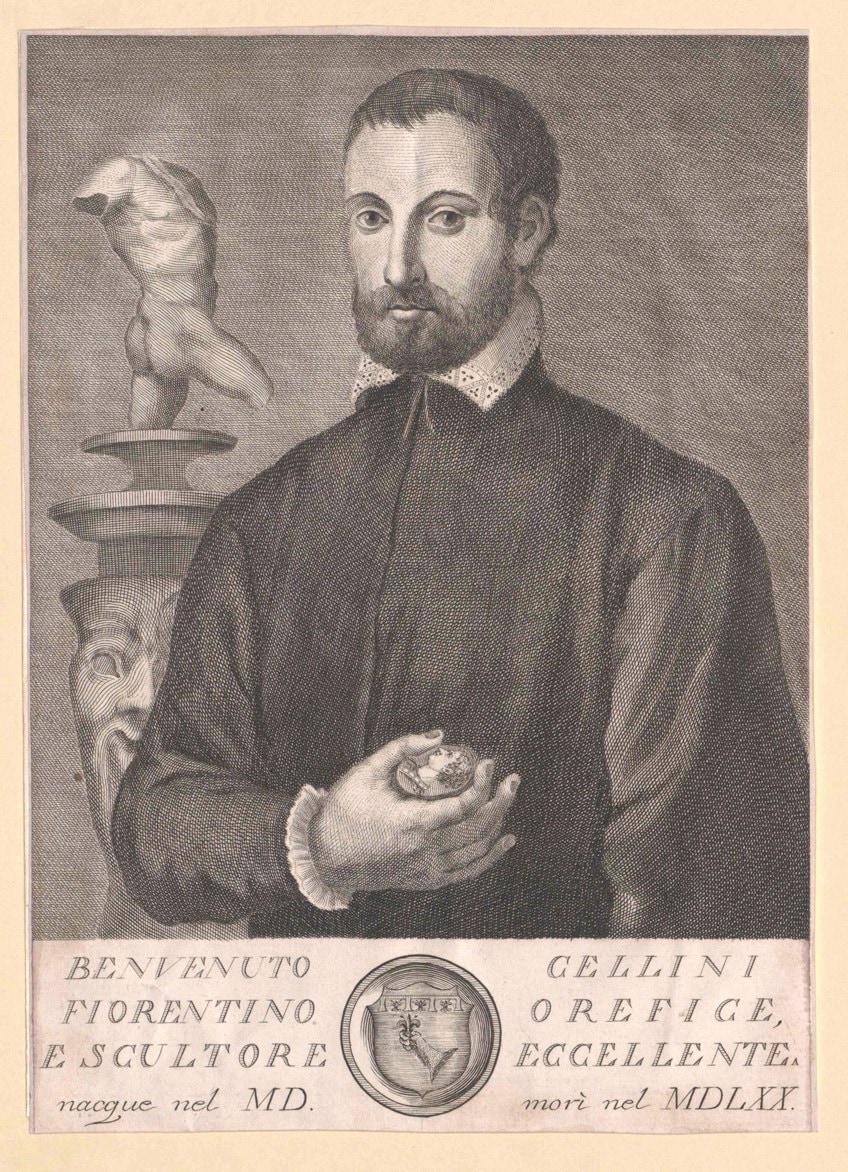
Cellini, on the other hand, desired to be considered in a comparable league as Michelangelo. While Cellini was prodigious at times and his talent was obvious, his encounters with the authorities also defined him. He was frequently charged with sexual offenses, burglary, and even homicide.
Let us now take a look at the original sculpture that was inspired by the Greek myth.
Perseus and the Head of Medusa (1554) by Benvenuto Cellini
| Date Completed | 1554 |
| Medium | Bronze Sculpture |
| Dimensions | 550 cm |
| Currently Located | Loggia Dei Lanzi |
While Caravaggio is typically identified as the problematic bad-boy prodigy, renowned for drinking, brawls, and even being accused of murder, Benvenuto Cellini was a similarly crazy, egotistical, and disturbing figure. Cellini is regarded as the finest Renaissance craftsman; indeed, the incomparable Michelangelo characterized him as the finest goldsmith of which we have ever known.
Cellini, on the other hand, desired to be considered in a comparable league as Michelangelo. While Cellini was prodigious at times and his talent was obvious, his encounters with the authorities also defined him. He was frequently charged with sexual offenses, burglary, and even homicide.
Cellini, in classic Florentine flair, transports us to classical Antiquity and the myth of how the warrior Perseus, replete with flying sandals provided by Hermes and a bag (in which he hid the grisly head) provided by Athena, encountered and beheaded the infamous Medusa.
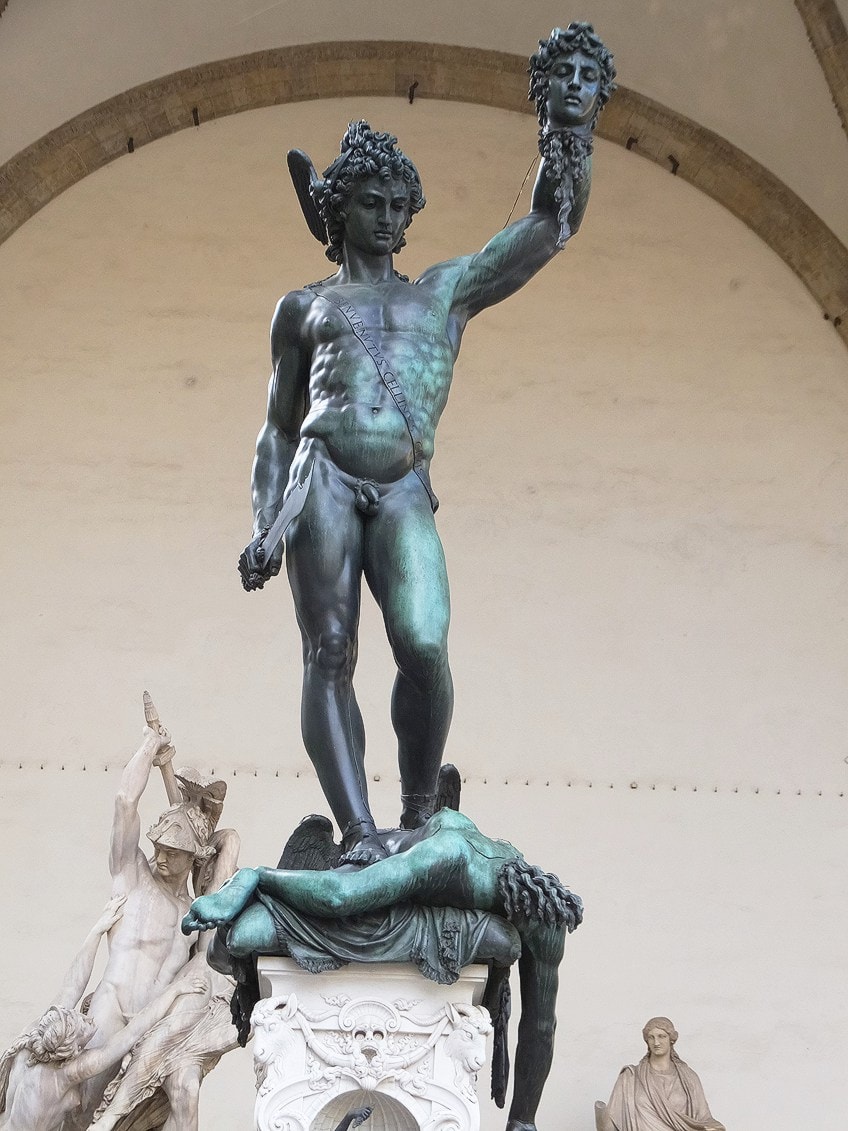
Cellini displays his sculpture in all its horrific grandeur, including the pouring blood from the decapitated head he clutches and the flailing corpse he balances on. Cellini’s remarkable accomplishment and skill in producing the entire artwork from a single block of bronze, something seldom done, especially with a work of such intricacy, is crucial to the tale of the sculpture.
Despite the fact that he was contending against enormous masterpieces such as the David statue by Michelangelo, Cellini desired to distinguish himself and secure his position among Florentine greats. According to legend, when the sculpture was being produced in Cellini’s studio, an aged and ailing Cellini lay paralyzed on his bed at home. A storm blew in, and in the darkness, Cellini’s helpers struggled to keep track of everything, and the bronze began to coagulate as it chilled. Cellini sprang from his bed, yelling and commanding that everything conceivable be thrown into the flames to boost the temperature. The heat began to increase just enough, and the artwork was preserved.
Cellini compared the resurrection to reviving the dead, implying not only the preservation of the magnificent artwork but also the rescue of Cellini personally.

This Medusa and Perseus statue, like most Renaissance artwork, is accompanied by geopolitics and symbolism. It was ordered in 1545 by the famous Cosimo I de Medici, a renowned benefactor of the crafts, scholarship, and philosophies. The monument had a social significance and symbolized the authority of the Duke who had ‘beheaded’ the Republic.” Medusa represents the Republican attempt, and the serpents that emerge from her body represent the conflicts that have always plagued democracies. All highly meaningful and strategic, commemorating the Medici’s power over the Florentine populace through the figure, Perseus.
Now that we have covered the original sculpture, let us take a look at the artist and artwork that has caused such a stir.
The Artist Behind the Controversial Medusa and Perseus Sculpture: Luciano Garbati
| Nationality | Argentinian |
| Date of Birth | 1973 |
| Place of Birth | Argentina |
| Associated Mediums | Sculpture |
Luciano Garbati was born in 1973 in Argentina. He joined the National School of Arts and qualified in 1996 as a Sculpture professor. Throughout those years, he traveled to Carrara, Italy, numerous times to learn sculpting skills. In 2001 in Buenos Aires, during his third year at the Superior School of Arts, he earned a scholarship from the Italian Culture Institute to study sculpting in Rome, Italy. He also took many classes to acquire other methods like bronze casting or fiberglass and resin use, as well as scholastic lectures in ethics and aesthetic appeal and directed intellectual introspection on his own works.
His major interests in his oeuvre have been the physically and psychologically oriented changes, alterations, and modifications that occur in the body’s continual and unavoidable variation towards otherness.
These occurrences are mirrored and condensed on classically inspired sculptures, with a specific focus on the Italian Baroque and Mannerist stylistic heritage. The artwork, therefore, becomes a manifestation of a certain condition of the person, a permeable physiological organism whose boundaries and form are tragically sporadic. The sculptor has been appointed to work on marble and bronze monuments for the city of Chascomus and, as well as many group exhibits and solo exhibitions at some of the most renowned public organizations.
Medusa With the Head of Perseus (2008) by Luciano Garbati
| Date Completed | 2008 |
| Medium | Clay and Resin |
| Dimensions | 200 cm |
| Currently Located | Collect Pond Park, Lower Manhattan |
The image has become iconic: she stands nude, her tresses a mass of serpents, a blade in one hand, a decapitated head in another, in the throes of an uncomfortable, unprompted duty. Her demeanor is steadfast rather than victorious. This 2008 sculpture of a re-imagined tale by Luciano Garbati, went viral throughout social media, as the appropriate embodiment for a phase of feminine anger.
There’s a lot to be furious about in the ancient Greek tale of Medusa. Poseidon violates a mortal girl at Athena’s sanctuary before transforming her into the hideous monster with serpents for hair. Medusa is subsequently punished by the deity, who transforms her into a Gorgon and exiles her. Afterward, Perseus is dispatched on a mission to carry Medusa’s head to King Polydectes. Perseus sneaks up on Medusa while she is asleep, decapitates, and then employs it as a device to turn foes into stone, armed with a reflective shield, flying footwear, and a unique pouch for her head.
Garbati began to dispute Medusa’s portrayal as a villain, noting that she was “sexually assaulted, condemned, and murdered.”
Garbati grew up in Italy, in a tiny village near Florence, where Cellini’s famed Perseus with the Head of Medusa statue stands in the Loggia Dei Lanzi and Caravaggio’s Medusa artwork is displayed at the Uffizi Gallery.
Cellini’s art had always stunned him since he was a youngster. There were many representations of Medusa, and they all depicted the tale at its ugliest. As a sculptor, he became obsessed with one issue: “How would it appear, her triumph rather than his?” “How should such an artwork be fashioned?”
Garbati’s Medusa had been languishing in comparative anonymity prior to the limelight on digital media. Despite the fact that he carved her in clay and subsequently molded her in resins with fiberglass support a decade earlier, the piece has only appeared in one exhibition and is still obtainable in the original form for $35,000, or in metal for roughly $25,000 extra, dependent on the studio. She’s bigger than life, towering more than two meters tall. “I was picturing Perseus, this hero with all his equipment, coming there and winning,” Garbati explained.
“The distinction between a male triumph and a female success was fundamental to my art.”
“Perseus is constantly highlighting the notion that he triumphed, presenting the head, whereas if you observe my Medusa’s expression, she is resolute, she had to accomplish what she achieved since she was protecting herself. It’s a very terrible situation.” Earlier that year, Garbati shared photographs of the artwork on his Facebook page. He observed friends, and then subsequently friends of friends, and eventually others he didn’t recognize at all, who were using the photograph to convey their feelings to the news or as a cover photo.
The picture was distributed even further when an Italian writer called Sara Giovinazzi released a blog article in which he utilized his artwork to ponder on the concept of mythic inversions. When Medusa began to appear on Instagram, Twitter, and Reddit, Garbati took to Twitter to politely inform followers that he was the creator behind the piece and that the statue was not in Florence, Italy, as some had claimed, but at his workshop in Argentina.
Garbati says he was pleased to discover a new generation of fans for an older piece, but what struck him the most were the comments regarding Medusa and his rendition of the narrative.
Medusa with the Head of Perseus and the Feminist Movement
Much of the online popularity of the sculpture was due to its association with the feminist and #MeToo movements. The #MeToo movement, along with permutations of comparable regional or worldwide identities, is a societal initiative opposing sexual assault and exploitation in which individuals publish sexual offense claims. The goal of “Me Too,” like other social equality and autonomy initiatives based on trying to break secrecy, is to encourage and facilitate sexually abused people through compassion and cooperation through mutual support, particularly weak and impressionable girls, by visually illustrating how many have withstood sexual harassment and assault, particularly in the workplace.
Garbati’s monument rose to prominence online amid the revelation of Weinstein’s sexual misconduct and the rise of the #MeToo campaign. In 2018, a photo of the monument was shared on social media with the message “Be thankful, we simply want fairness, not retaliation.”
Certain critics, nevertheless, doubt the figure’s position as a feminist sculpture. Numerous critics claimed that the monument would be more appropriate as a #MeToo declaration if Medusa were beheading Poseidon, her rapist. Others disputed the feminist benefit of prominently displaying a male sculptor’s image of a nude, objectively attractive female. According to another columnist, the figurine is conceptual art 101 at its most apparent and unsophisticated. Anybody who observes the sculpture, reads the inscription, and remembers the underlying story will immediately “get it.”
“It is an immensely loaded artwork, and it is reasonable that people have an emotional response to the piece,” one fan said. The truth is that both myth and reality are recounted through the eyes of a storyteller who has an unconscious bias. However, inverting the myth upsets what many believe to be a permanent past, which can be unsettling.”
Bek Andersen, a New York–based photographer, initiated plans to place the monument in Manhattan, collaborating with Garbati to develop a bid for the area’s “Art in the Parks” initiative. She also created “Medusa With The Head”, an artistic group dedicated to reimagining legendary stories. Garbati’s work, according to Andersen, asks, “How can a victory be conceivable if you are vanquishing a victim?”
Today we have seen how this reversal of roles, with Medusa holding Perseus’s head, has become a symbol for the feminist movement. From Garbati’s childhood musings of Benvenuto Cellini’s Perseus statue, through to the contemporary world of social media – the Greek tale has undergone a total shift in meaning by reevaluating the myth through a modern lens. For those within the #MeToo movement, this is a significant shift in the power roles associated with the genders, whereas for its detractors, it is a slightly sexualized male portrayal of a misinterpreted subject matter.
Take a look at our Medusa statue webstory here!
Frequently Asked Questions
Where Does the Story of Medusa and Perseus Originate?
It is an old mythological tale that originates from ancient Greece. As with many tales from that era, it involves the interaction of the gods and mere mortals. For many people, the tale warns of how the gods simply used humans for their own means and would hand out punishment to even their most ardent followers.
Why Is Medusa with the Head of Perseus Important?
For many people, this artwork represents a change in the way we view old stories without questioning them. Many of these tales were created in a time where values of social equality were not common, and women were often punished for things they were not in control of. For many people, this artwork represents a shift from an environment where a woman is blamed for her rape, to one wherein she claims justice and victory over the men who try to hurt her.
Isabella studied at the University of Cape Town in South Africa and graduated with a Bachelor of Arts majoring in English Literature & Language and Psychology. Throughout her undergraduate years, she took Art History as an additional subject and absolutely loved it. Building on from her art history knowledge that began in high school, art has always been a particular area of fascination for her. From learning about artworks previously unknown to her, or sharpening her existing understanding of specific works, the ability to continue learning within this interesting sphere excites her greatly.
Her focal points of interest in art history encompass profiling specific artists and art movements, as it is these areas where she is able to really dig deep into the rich narrative of the art world. Additionally, she particularly enjoys exploring the different artistic styles of the 20th century, as well as the important impact that female artists have had on the development of art history.
Learn more about Isabella Meyer and the Art in Context Team.
Cite this Article
Isabella, Meyer, “Medusa With the Head of Perseus – A Fresh Take on the Perseus Statue.” Art in Context. October 17, 2021. URL: https://artincontext.org/medusa-with-the-head-of-perseus/
Meyer, I. (2021, 17 October). Medusa With the Head of Perseus – A Fresh Take on the Perseus Statue. Art in Context. https://artincontext.org/medusa-with-the-head-of-perseus/
Meyer, Isabella. “Medusa With the Head of Perseus – A Fresh Take on the Perseus Statue.” Art in Context, October 17, 2021. https://artincontext.org/medusa-with-the-head-of-perseus/.




